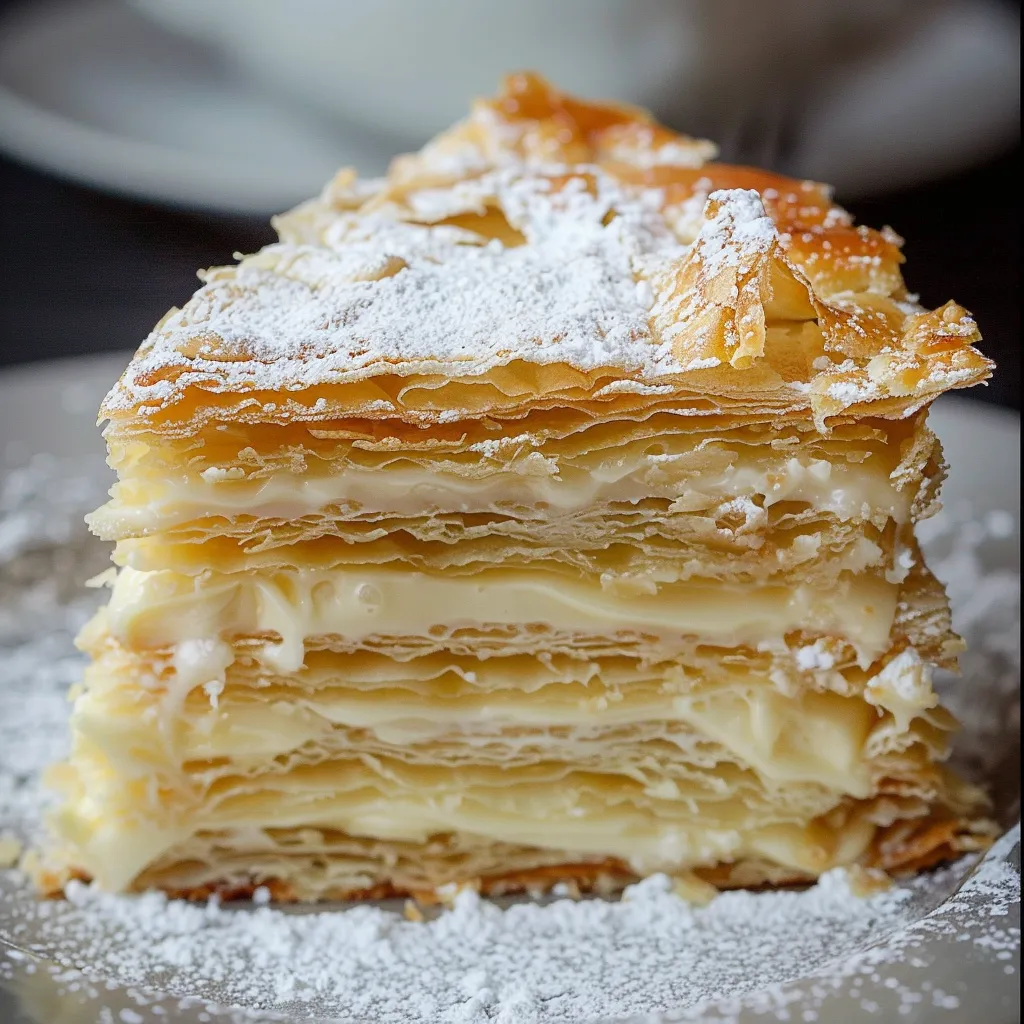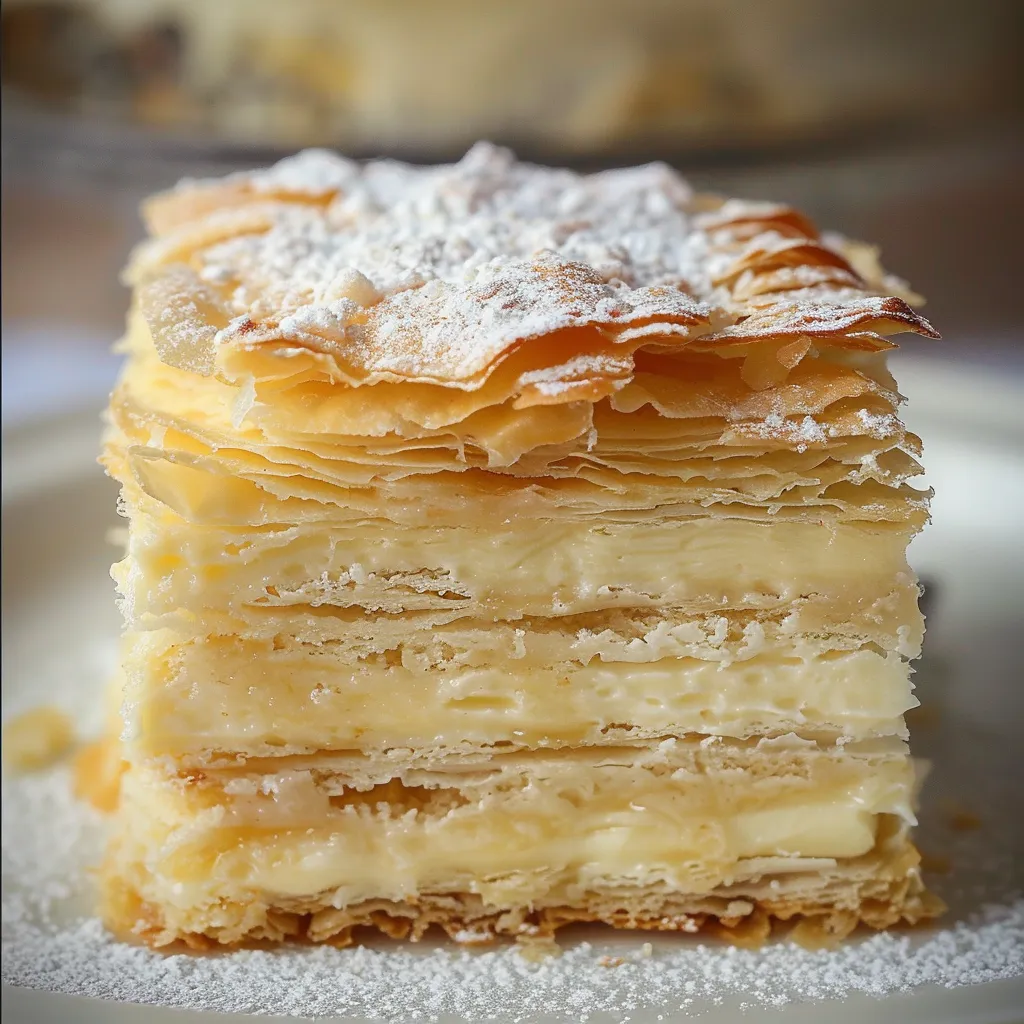 Pin it
Pin it
This classic Russian Napoleon cake with its flaky layers is my go-to sweet treat for special get-togethers. You always get that real-deal vibe and guests are wowed every time.
My grandma made this dessert for every family celebration. After lots of trial and error, I finally pulled off a version that brings back the best childhood memories.
Ingredients
- Quick puff pastry
- Cold unsalted butter: This creates those flakey, rich layers.
- Eggs: They make the dough sturdy and give it that richness.
- Chilled water: Keeps everything cool so the butter doesn't melt out.
- Sifted flour: Makes sure your pastry turns out airy and light.
- Vodka or brandy: Adds extra tenderness and stops the dough from getting tough.
- White vinegar: Helps get those great flaky layers too.
- Salt: Brings out all the other flavors.
- For the egg yolk custard
- Egg yolks: These make everything creamy and smooth—totally necessary.
- Whole milk: Gives you the richest flavor and just the right consistency.
- Granulated sugar: Sweetens things up just right.
- Vanilla extract: Adds that cozy, deep aroma.
- Sifted flour: Thickens up the custard without any annoying lumps.
- Unsalted butter: Rounds it all out with a silky finish.
Step-by-Step Instructions
- Quick puff pastry prep
- Mix up the liquids: Whisk your eggs and salt together. Add water, vinegar, and booze. Stir until smooth—that's what's going to hydrate your dough.
- Combine flour and butter: Use a food processor and pulse the cold butter with flour till it looks like crumbly peas. This is what turns your dough into flaky heaven.
- Add the liquid: Slowly pour in the egg mix while pulsing until the dough's just starting to come together. Don't overmix—it shouldn't be totally uniform.
- Shape the dough: Dump it onto your counter and gently push it together as little as possible so those chunks of butter stick around. That'll give you nice separated layers.
- Split and chill: Cut the dough into four, squish each into a disk, wrap in plastic, and chill for at least 1–2 hours. Gives the flour time to soak things up and the butter to firm up.
- Custard filling prep
- Start the mix: Whip together yolks and sugar, then splash in a bit of milk to thin. Stir in flour until smooth—no clumps allowed.
- Heat milk: Warm up the rest of your milk while stirring so it doesn't scorch. Slowly add it to your egg mix, whisking quick as you go.
- Cook the custard: Bring the whole thing to a simmer on medium. Keep whisking until it thickens and you lose that raw flour taste—should take just a few minutes.
- Flavor boost: Stir in vanilla and the butter. Whisk till the butter melts and everything's glossy.
- Let it chill: Pour the custard onto a rimmed pan, press plastic right against it so there's no skin, then let it cool down completely.
- Baking the pastry layers
- Get set up: Heat your oven to 200°C. Flip over a baking sheet and rest it on a damp towel.
- Roll it out: Take one dough piece at a time, cut it in half, then roll each bit out flat and thin—aim for a 32 cm circle—straight onto your sheet.
- Bake: Poke the circles with a fork so they don't balloon up. Bake 5–7 minutes until they're just golden. Keep an eye out—they brown fast.
- Trim to size: When they're hot, use a 28 cm guide to cut a perfect circle. Save the bits you cut off for decorating later.
- Repeat: Do the same with the rest so you end up with 8 circles and a stash of scraps. Crumble those scraps up for the final touch.
- Assembling everything
- Divvy up the custard: Split the cooled filling into 8 even piles, so each pastry layer gets a fair share.
- Build your base: Dab a spoonful of filling on your platter. Pop on the first pastry round and ring it with a cake collar or adjustable tin to hold its shape.
- Stack it up: Spread custard over that first layer, add another pastry round, then keep going until you've used every layer and finish with more custard on top.
- Add the crumb coat: Press the crumbled pastry scraps over the top, then slide a thin knife around the edge before removing the ring carefully.
- Finish up: Smother the sides with leftover custard, stick the crumbs all around, then gently shake the platter to shake off any extra bits.
I'm extra attached to the vodka in the dough. My Russian grandma swore by it to keep the gluten from acting up so the pastry stays extra tender. That moment I first tried the cake after letting it rest and mellow out—wow, now I know why folks call it a legend in Russian kitchens.
 Pin it
Pin it
Storage and Serving
This Napoleon keeps well in the fridge for up to 5 days. Loosely cover it with foil—don't squish the sides so your decorations stay pretty. Over time, the layers just keep soaking up the custard and it gets even softer.
Twists and Swaps
If you don't want to use alcohol, just swap in the same amount of ice-cold water. Try adding a little lemon zest, orange zest, or a sprinkle of cinnamon to the custard for your own spin. Want to go lighter? Use 2% milk instead of whole—it just won't be as rich.
History Notes
The Russian Napoleon cake supposedly popped up after Napoleon’s 1812 defeat. Bakers shaped it like a tricorn hat to celebrate their win. Over time, it became a regular at Russian festive tables—every family tweaks it a bit. French mille-feuille uses regular puff pastry, but this one leans on that fast, homemade style.
Serving Suggestions
For that wow look, dust on some powdered sugar and toss a few fresh berries on top. Pour strong black tea for the full Russian vibe. At parties, try it with sweetened crème fraîche or a scoop of vanilla ice cream beside each slice.
Frequently Asked Questions
- → What’s the fastest way to make flaky dough?
Blend cold butter chunks with sifted flour to get a crumbly texture. Mix in a liquid combo of eggs, chilled water, vinegar, and vodka. Quickly pull the dough together without overworking it, then chill before shaping the layers.
- → Can I skip the alcohol in the dough?
Absolutely, swap the vodka or cognac for cold water, and the dough will still turn out great.
- → How do I keep custard super smooth?
Whisk while it cooks, and, if you spot any lumps, strain the cream through a fine sieve for a flawless finish.
- → What’s the perfect serving temperature for this dessert?
For a soft texture, let it sit at room temperature after taking it out of the fridge. It helps the pastry absorb the cream completely.
- → What’s the best way to store this dessert?
Keep it covered in the fridge for up to 2-3 days. You can also store the pastry and cream separately and assemble them just before serving.
